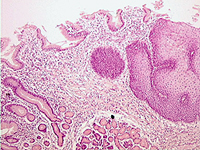 Examine a longitudinal section of
the esophago-gastric junction (slide 142). Note the abrupt, major
change in the lining epithelium and the effect this has on the
underlying mucosa (Fig. 15-17). Examine a longitudinal section of
the esophago-gastric junction (slide 142). Note the abrupt, major
change in the lining epithelium and the effect this has on the
underlying mucosa (Fig. 15-17).
What do the different epithelial linings in the esophagus and
stomach indicate about the functions of these two organs?
 Clinical note: If the
muscularis of the lower esophagus fails to maintain the state of
partial contraction that normally prevents reflux of the gastric
contents upward, heartburn results. Since the esophageal mucosa
lacks a thick blanket of protective mucus, acidic gastric juices
irritate it, causing painful esophagitis. If chronic, this is called
gastro-esophageal reflux disorder (GERD) and can lead to metaplasia
of stratified squamous epithelium into a simple columnar, mucous
epithelium. (Image courtesy of
WebMD) Clinical note: If the
muscularis of the lower esophagus fails to maintain the state of
partial contraction that normally prevents reflux of the gastric
contents upward, heartburn results. Since the esophageal mucosa
lacks a thick blanket of protective mucus, acidic gastric juices
irritate it, causing painful esophagitis. If chronic, this is called
gastro-esophageal reflux disorder (GERD) and can lead to metaplasia
of stratified squamous epithelium into a simple columnar, mucous
epithelium. (Image courtesy of
WebMD)
Now to the stomach. |